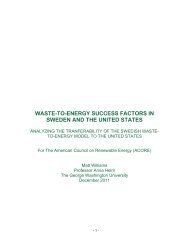systems, agree to buy green power during the summerwhen the schools are not using it, and place price guaranteeson the electricity that a green school consumes—especially the electricity it produces. If federal incentivesor rebates were linked directly to green schools, thatwould make green school construction and renovationeven more affordable.TransportationA green school is not complete without greeningthe transportation to and from school—and thatstarts with the buses.The United States has a fleet of 60,000school buses, and for every bus on theroad, 30 cars are eliminated. While the newestschool buses can achieve 7 mpg, if we factor inthe number of passengers ferried, the fuelefficiency improves to 252 mpg. Considered inthis light, buses can be seen to be a highlyefficient and effective mode of transportation.In addition, half of the new buses have a specialidling shut-off which cuts out 50% of their fuelconsumption. In fact, new technology allows fordiesel buses to have lower emissions and to runcleaner than traditional gasoline-powered cars.Drivers and maintenance workers must betrained properly and be aware of the school’smission to have a cleaner, greener schoolbus fleet.Green schools should provide training to school busdrivers and maintenance workers to reduce bus idlingwhen possible, check tire pressure, and to start and stopbusses efficiently. The EPA runs a comprehensive GreenSchool Bus Program and all schools are encouraged to join.money. Further, renewable energy industriescreate roughly triple the number of good jobs —paying at least $16 dollars an hour —as the oilindustry could create with the same amount ofmoney.Green jobs will revitalize the <strong>American</strong> economyand substantially curb the rising unemploymentrates.Green jobs have the potential to reduce the unemploymentrate to 4.4 percent, from 5.7 percent (calculatedwithin the framework of US labor market conditions inJuly 2008). Green job training would bolster employment,especially in domestic construction and manufacturing.Specifically, the Green Recovery program can, at least,bring back 800,000 construction and skilled labor jobs.ConclusionsWith 40 percent of all energy consumed in theUnited States being consumed by buildings,there is substantial room for improvement inconservation and efficiency across the <strong>American</strong>infrastructure. Building renovations andmodifications can significantly reduce totalenergy usage and greenhouse gas emissions. Astandard for new construction of green buildingsand communities would ensure that futurebuildings will be more environmentally-friendlyand sustainable. These conservation andefficiency measures would breed the adoptionof environmental awareness and green lifestylechoices, and coupled with increased renewableenergy production, could easily make a bettertomorrow for the next generation.Green Jobs<strong>Renewable</strong> energy industries create more jobsthan the oil industry does.<strong>Renewable</strong> energy industries can createnearly four times more total jobs than theoil industry can create with the same amount of<strong>American</strong> <strong>Council</strong> <strong>On</strong> <strong>Renewable</strong> <strong>Energy</strong>Executive Summary Report 30
Session ReferencesGreen Schools BreakfastJerome Ringo, President, Apollo AllianceLowell Rasmussen, Vice Chancellor, University of Minnesota-MorrisRachel Gutter, Senior Manager, Education Sector, U.S. Green Building <strong>Council</strong> (USGBC)Rich Costello, President, Acela <strong>Energy</strong>Brett KenCairn, Executive Director, Veterans Green JobsSteven Pucke, First Group TransitWilliam Naubert, President, Project EverGreen SchoolsJ. Paul Gerner, Associate Superintendent of Utilities, Clark County School District, NevadaMel Jones, CEO, Sterling PlanetF2 – Green SchoolsRachel Gutter, Sr. Manager, Education Sector, U.S. Green Building <strong>Council</strong> (Chair) [slides]Paul Polizzotto, CEO, EcoMedia [slides]Gary Westerholm, Executive Advisor, Project Evergreen Schools [slides]Paul Gerner, Associate Superintendent of Utilities, Clark County School District, Las Vegas, Nevada [slides]F3 – Green CitiesChristine Ervin, President, Christine Ervin Company (Chair)Mary Tucker, <strong>Energy</strong> Program Manager, City of San Jose [slides]Lowell Rasmussen, Vice Chancellor, University of Minnesota Morris [slides]Jerome Ringo, President, Apollo AllianceF4 – Green CompaniesMatt Clouse, Director, <strong>Renewable</strong> <strong>Energy</strong> Policy and Programs, US Environmental Protection Agency (Chair)Roger Ballentine, President, Green StrategiesJeff Krech, Global Facilities Global Sustainability Program Manager, Dell Inc. [slides]Michelle Price, Base <strong>Energy</strong> Manager, 99 CES/CEAO, US Air Force[slides]Marty Sedler, Director, Global Utilities and Infrastructure, Intel Corporation [slides]Andrew Singer, Senior Vice President, Constellation New<strong>Energy</strong> [slides]F7 - Green BuildingsCurtis Clark, Sustainability & <strong>Energy</strong> Consultant, GSBS Architects (Chair) [slides]Ralph DiNola, Principal, Green Building Services, Inc. [slides]Shelley Fidler, Principal, Governmental Affairs, <strong>Energy</strong> & Environmental Policy, VanNess Feldman [slides]Elizabeth Francis, Partner, Mario Cucinella ArchitectsDeb Kuo, Director, Real Estate, Exelon Corporation [slides]Kevin Hydes, CEO, Integral and Past Chair, World Green Building <strong>Council</strong> [slides]F8 – Green (DREAM) JobsCheri Olf, Director of Education and International Workforce, <strong>American</strong> <strong>Council</strong> <strong>On</strong> <strong>Renewable</strong> <strong>Energy</strong> (ACORE) (Chair)Brett KenCairn, Executive Director, Veterans Green JobsDawn Dzurilla, President, Gaia Human Capital Consultants<strong>American</strong> <strong>Council</strong> <strong>On</strong> <strong>Renewable</strong> <strong>Energy</strong>Executive Summary Report 31
- Page 6: The highlights of WIREC 2008 includ
- Page 9 and 10: EVENT SPONSORSHosted byBadge Sponso
- Page 11 and 12: EXHIBITORS ContinuedKamatics Corp.K
- Page 13 and 14: The ARRA contains the following ite
- Page 15 and 16: “How do we organize ourselves to
- Page 17 and 18: John GeesmanFormer Commissioner, Ca
- Page 19 and 20: Cathy ZoiCEO, Alliance for Climate
- Page 21 and 22: John CavalierManaging Partner, Huds
- Page 23 and 24: BiofuelsChristopher Groobey, Partne
- Page 25 and 26: Patrick Cloney, Executive Director,
- Page 27 and 28: Gal Luft, Executive Director, Insti
- Page 29 and 30: Daniel Kammen, Class of 1935 Distin
- Page 31 and 32: Biomass, Biofuels, and Advanced Veh
- Page 33 and 34: Critical development opportunities
- Page 35 and 36: ConclusionsSpeakers at RETECH 2009
- Page 37 and 38: Geothermal PowerOverviewThe United
- Page 39 and 40: Green Buildings and CommunitiesOver
- Page 41: Green construction and renovation s
- Page 45 and 46: 1. The local electric power market
- Page 47 and 48: International Renewable Energy Indu
- Page 49 and 50: production was 37%; the domestic tu
- Page 51 and 52: There have been a number of incenti
- Page 53 and 54: educes mortality and improves gende
- Page 55 and 56: D7 - ChinaJing Su, Director of US-C
- Page 57 and 58: past, uncertain legislative environ
- Page 59 and 60: marketplace, accelerating and deepe
- Page 61 and 62: • Complexity and operating costs
- Page 63 and 64: C6 - Environmental and Carbon Finan
- Page 65 and 66: The technology debate: thin film ve
- Page 67 and 68: FITs have grown in popularity over
- Page 69 and 70: Haroula Reitz, Global Manager of Sc
- Page 71 and 72: Currently, planning is geographical
- Page 73 and 74: Federal policy should allow for a c
- Page 75 and 76: Wind: Markets, Technologies, and Po
- Page 77 and 78: Regional FactorsBesides federal pol













